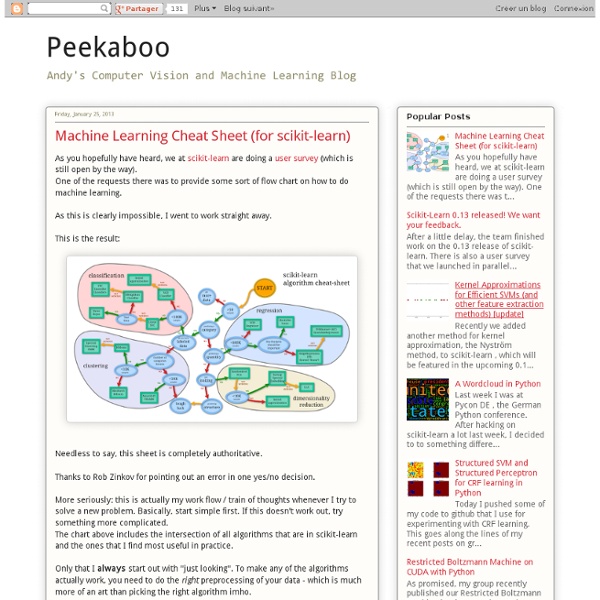



GUESS: The Graph Exploration System Madame Fabienne vous propose des idées toutes simples Lécole face à lobscurantisme religieux Paul-François Paoli et Alain Seksig (dir.), Max Milo, 2006, 377 p., 20 e. Mensuel N° 176 - Novembre 2006 Le rapport sur « Les signes et manifestations d’appartenance religieuse dans les établissements scolaires » (1984), piloté par l’inspecteur général Jean-Pierre Obin, est longtemps resté relativement confidentiel. Sa publication accompagnée des réactions d’une vingtaine de personnalités est donc salutaire.L’étude s’appuie sur une enquête menée dans quelques dizaines d’établissements secondaires a priori concernés, répartis sur une vingtaine de départements. Elle n’a donc pas prétention à être représentative de l’ensemble. Soutenez-nous Sciences Humaines est un journal unique qui se consacre à l'étude de l'humain dans toutes ses dimensions, un journal humaniste attaché à l'idéal de progrès, un journal indépendant qui ne vit que de ses lecteurs. LIRE LA LETTRE AUX LECTEURS d'Héloïse Lhérété *Don défiscalisé
GitHub - airbnb/caravel: Caravel is a data exploration platform designed to be visual, intuitive, and interactive Madame Martine vous suggère aussi : Low-level w/ full algorthms A single-layer network has severe restrictions: the class of tasks that can be accomplished is very limited. In this chapter we will focus on feed-forward networks with layers of processing units. Minsky and Papert (Minsky & Papert, 1969) showed in 1969 that a two layer feed-forward network can overcome many restrictions, but did not present a solution to the problem of how to adjust the weights from input to hidden units. An answer to this question was presented by Rumelhart, Hinton and Williams in 1986 (Rumelhart, Hinton, & Williams, 1986), and similar solutions appeared to have been published earlier (Werbos, 1974; Parker, 1985; Cun, 1985). The central idea behind this solution is that the errors for the units of the hidden layer are determined by back-propagating the errors of the units of the output layer. For this reason the method is often called the back-propagation learning rule. Multi-layer feed-forward networks A feed-forward network has a layered structure. Delta Rule in which
Blog Le dessous des "labs" Billet publié par Stéphane Vincent Vous en avez assez des "labs" ? Difficile de vous le reprocher... Labs2, une initiative de Kennisland C’est pourquoi la rencontre Labs2 initiée les 24 et 25 avril dernier à Amsterdam par le think-tank hollandais Kennisland et l’organisme de coopération Hivos venait à point nommé. Des labs sur tous les thèmes Les participants venaient du monde entier et reflétaient une très grande diversité d’objectifs et de thèmes : en Afrique du Sud, Ushahidi anime un logiciel de crowdsourcing, né après la crise au Kenya en 2007 à la suite de l’élection présidentielle pour collecter les témoignages de violence envoyés par email et SMS et les placer sur Google Maps ; en Grande-Bretagne, le Finance Lab explore de nouveaux modèles de systèmes financiers au services des populations ; au Cambodge, le Human Centered Innovation Lab co-conçoit des équipements du quotidien avec les habitants. Quel est le core-business des labs ? Ethno, proto, carto
Logo : Combien on coûtés les Logos de marques ? Dans la sphère mondiale des logos, on trouve de tout, de rien et surtout à tous les tarifs. Avec une simple recherche sur Google, vous trouverez des services en tous genres sur la création de Logo pour votre identité. Maintenant il faut savoir que derrière un logo il y a énormément de choses à respecter si vous voulez faire quelque chose de professionnel et cohérent avec votre marque. Vous pouvez d’ailleurs consulter le [Dossier] 12 erreurs à ne pas faire lors de la création d’un Logo sinon vous arrivez dans le prochain top 10 logos fail ! Sinon, dans l’infographie qui suit, créé par Logonews, vous allez voir une vingtaine de prix qui ont été pratiqués pour des marques que vous connaissez surement. Anpe, nike, pôle emploi et bien d’autres. Et bien on se rend compte qu’il y a vraiment tous les prix.
Logiciel éducatif enfant GCompris GCompris est un logiciel éducatif qui propose des activités variées aux enfants de 2 à 10 ans. Les activités sont quelquefois ludiques, mais toujours pédagogiques. Voici la liste des catégories d'activités avec quelques exemples : découverte de l'ordinateur : clavier, souris, écrans tactiles… lecture : lettres, mots, entraînement à la lecture, à l'écriture… mathématiques : révision des tables, dénombrement, les tables à double entrée… sciences : l'écluse, le cycle de l'eau, l'énergie renouvelable… géographie : pays, régions, culture… jeux : les échecs, jeux de mémoire, le puissance 4, le pendu, le morpion… autres : couleurs, formes, le Braille, apprendre à dire l'heure… En tout, GCompris propose plus de 100 activités et il continue à évoluer. Le projet GCompris est hébergé et développé par la communauté KDE.
Claude BOURGUIGNON Microbiologiste des Sols - Agricultiver En tant que spécialiste de la vie des sols, pouvez-vous estimer le pourcentage des sols de France atteints par la pollution (et dans quelle proportion) ? – Claude Bourguignon : 10% des sols sont pollués par des métaux lourds. 60% sont frappés d’érosion. 90% ont une activité biologique trop faible et en particulier un taux de champignons trop bas. Idem dans le monde. Qu’est-ce que c’est pour vous, un sol ? – C. Sur trente centimêtres d’épaisseur, le sol héberge 8O % de la biomasse vivante du globe. – C’est le moment où vos ennuis commencent avec l’Inra ? – Claude Bourguignon : Exactement. Quelle a été votre démarche au début de vos recherches ? – Claude Bourguignon : J’ai essayé de comprendre pourquoi certains sols étaient plus vivants que d’autres. Quelle est votre vision du rapport de l’homme à la terre, et à l’agriculture ? – Claude Bourguignon : L’agriculture est d’abord l’histoire tragique de 15 000 ans de famine. Le sol est une matière vivante. Alors comment fait-elle ? Bon.